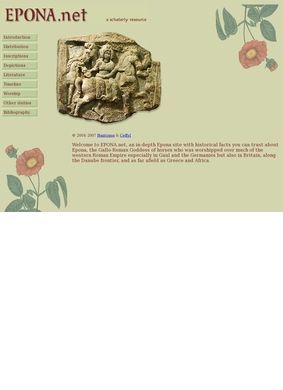The website EPONA.net provides an encyclopedic investigation into the Gallo-Roman Goddess of horses, Epona. Presented in an academically rigorous yet accessible fashion, the site aims to offer a versatile and comprehensive overview of this deity. The structure is straightforward and easy-to-follow, equipped with multiple subcategories catering to an array of inquiries.
Immediately, the site stands out for its thorough conveyance of Epona's geographical distribution. With a wide scope that spans France, Germany, Britain, the Danube frontier, Greece, and Africa, it affords visitors an expansive canvas to understand the breadth of Epona's reach across the Western Roman Empire.
Equally compelling is the substantial collection of inscriptions available on the website. These artifacts serve as valuable historical records, providing firsthand textual insights into Epona's worshippers and devotees. The meticulous documentation enhances the site's scholarly heft, adding depth to its explorations.
Furthermore, the generously stocked section on depiction exhibits a vast range of iconographies associated with Epona. This visual component offers another layer of engagement, assisting visitors in envisioning the Goddess's manifold representations. It offers a robust visual historical narrative to enthusiasts, enhancing their understanding of the deity's pictorial range in ancient times.
The site also includes a section dedicated to literature related to the Goddess. This subsection provides a solid theoretical backdrop for the experiential content present elsewhere on the site. It reveals in depth the academic discourse surrounding Epona, reinforcing the site's commitment to comprehensive and well-rounded content delivery.
Moreover, the site's chronological timeline offers a clear and concise historical progression of Epona's worship. Utilizing an interactive visual aid allows users to grasp the complexities of Epona's history more intuitively.
Yet, aside from its focus on Epona, the site explores other deities, introducing users to the complex fabric of the Gallo-Roman pantheon. This comparative approach enlarges the site's purview, enhancing its contextual insights.
Lastly, the site's bibliography provides an accessible platform for further academic research, signposting users towards a wide range of additional resources.
Stylistically sparse, EPONA.net's strengths lie in its uncluttered, fact-heavy interface, offering a wealth of primary and secondary information. It showcases the versatility of online academic resources, boasting detailed research with digestible knowledge for both the layperson and scholar. Overall, EPONA.net is a commendable nod to digital scholarship in the field of historical pagan studies.
